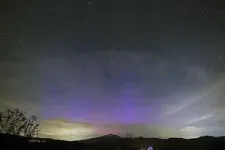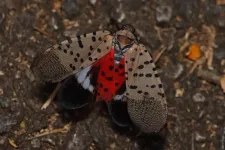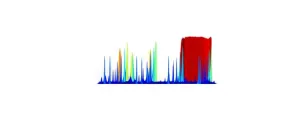(Press-News.org) Colorful auroras appeared around Japan's Honshu and Hokkaido islands on May 11, 2024, sparked by an intense magnetic storm. Usually, auroras observed at low latitudes appear red due to the emission of oxygen atoms. But on this day, a salmon pink aurora was observed throughout the night, while an unusually tall, blue-dominant aurora appeared shortly before midnight.
Smartphone videos and amateur photos captured the event, enabling scientists to combine public data with their own research and study the phenomenon.
In a new study, researchers analyzed the videos and images of the blue-dominant aurora to estimate the area of the phenomenon and confirmed the estimates with spectrophotometers. Published in the journal Earth, Planets and Space, the research was led by Sota Nanjo, a postdoctoral researcher at the Swedish Institute of Space Physics in Sweden, and Professor Kazuo Shiokawa from the Institute for Space-Earth Environmental Research (ISEE) at Nagoya University in Japan.
Nanjo and Shiokawa’s investigation provided the first visualization of the spatial structure of blue-dominant auroras during a storm. The researchers found that the auroras had longitudinal structures that were aligned with magnetic field lines, the first time they had been identified in a low-latitude, blue-dominant aurora. They also found that the aurora spanned about 1200 km in longitude, consisted of three separated structures, and ranged in altitude from 400-900 km.
Nanjo and Shiokawa’s findings may change our understanding of blue auroras. The ring current, a donut-shaped region of charged particles encircling Earth, is believed to be the source of energetic neutral atoms (ENAs) that produce low-latitude auroras, including the red aurora. According to this model, the storm likely energized the ENAs, creating a colorful display of light.
However, the group's discoveries cannot easily be explained by this mechanism. As Shiokawa explains: “In this study, a structure of several hundred kilometers was found in the blue-dominant aurora in the longitudinal direction, which is difficult to interpret by ENA activity only. In addition, ENAs are unlikely to create auroral structures aligned with magnetic field lines, as observed in this study.”
Another possibility was that the aurora was due to resonant scattering of nitrogen molecular ions caused by sunlight irradiation. However, the group's research suggests that a different process occurred, as sunlight only reached down to 700 km, not the 400 km observed by the researchers.
Instead, their results may indicate the intriguing possibility of an unidentified process. “Our findings suggest that nitrogen molecular ions may have accelerated upward by some mechanism and were responsible for the formation of the blue-dominant aurora,” Shiokawa said.
“To date, it is not well understood how nitrogen molecular ions with large molecular weight can exist at such high altitudes,” he continued. “Such ions are not easily able to exist for long periods of time due to their heavy mass and short dissociative-recombination time intervals; however, they are observed at high altitudes. The process is shrouded in mystery.”
Overall, repeated observations of blue-dominant auroras, such as the one observed in Japan, may provide clues to understand the principle behind how nitrogen can be found at these altitudes. As the process of nitrogen molecular ion outflow into the magnetosphere is important in everything from understanding geomagnetic storms and the radiation environment in space, these findings could help us understand the processes that take place hundreds of kilometers above us.
END
Researchers use data from citizen scientists to uncover the mysteries of a blue low-latitude aurora
2024-12-05
ELSE PRESS RELEASES FROM THIS DATE:
Possible colon cancer vaccine target uncovered in bacteria
2024-12-05
Higher rates of certain cancers in countries, such as the UK, may be linked to two particular strains of bacteria. Targeting these with treatments or vaccines could help reduce the risk of colorectal, bladder, and prostate cancers.
Researchers from the Wellcome Sanger Institute, the University of Helsinki, and collaborators investigated the differences in cancer incidence for colorectal, bladder and prostate cancers, and compared these to global data tracking Escherichia coli (E.coli) strains. Specifically, they looked at the dominant two E.coli strains that produce a substance that has been previously identified as a risk factor for colorectal cancer.
Their ...
Eating dark chocolate linked with reduced risk of type 2 diabetes
2024-12-05
Embargoed for release: Wednesday, Dec. 4, 6:30 PM ET
Key points:
Study participants who consumed at least five servings of any chocolate per week showed a 10% lower risk of type 2 diabetes (T2D) compared to those who rarely or never ate chocolate. Dark chocolate had an even bigger impact: Participants who consumed at least five servings of this chocolate per week showed a 21% lower risk of T2D.
Consumption of milk chocolate, but not dark chocolate, was not associated with T2D risk; it was associated ...
Eating dark but not milk chocolate linked to reduced risk of type 2 diabetes
2024-12-05
Eating five servings of dark chocolate a week is associated with a reduction in the risk of type 2 diabetes, according to a long-term US study published by The BMJ today.
Global rates of type 2 diabetes are set to rise to 700 million by 2045. Chocolate contains high levels of flavanols (a natural compound found in fruits and vegetables) which have been shown to promote heart health and reduce the risk of type 2 diabetes. But the link between chocolate consumption and risk of type 2 diabetes remains controversial due to inconsistent results.
In addition, most previous studies have not looked at whether eating dark and milk chocolate – which have different ...
End food and drink industry’s infiltration of UK children’s education, say experts
2024-12-05
An investigation published by The BMJ today reveals widespread influence of food and drink brands in schools and nurseries – through breakfast clubs, nutrition guidance, and healthy eating campaigns - while rates of obesity in the UK have worsened.
Experts say the tactics are “subtle but very problematic” and require much greater scrutiny and pushback.
Organisations influencing food provision and education in schools include Kellogg’s, Greggs, Nestle, and the British Nutrition Foundation, a “policy development” charity ...
Concerns over potential harms of tests advertised directly to consumers
2024-12-05
Better information and regulation are essential to protect consumers from potential harms of tests advertised directly to consumers, argue experts in The BMJ today.
Emma Gram at the University of Copenhagen and colleagues warn that consumers are at risk of buying products that do more harm than good and say the public needs high quality information and effective communication to protect consumers from unbalanced and misleading marketing.
Advances in diagnostic technology and digital health have increased the variety and volume of direct-to-consumer (DTC) tests, ...
War in Lebanon has turned a decade of education crisis into a catastrophe - report
2024-12-05
The recent conflict in Lebanon has deepened a national education crisis in which children have already lost up to 60% of school time over the past six years, new research warns.
The report, which will be launched on 5 December by the Centre for Lebanese Studies and the University of Cambridge’s REAL Centre, is the first to assess the state of education since Israel began its ground offensive in Lebanon in October. Using surveys and interviews with parents and teachers, it provides a snapshot of the situation a few weeks before the new ceasefire between Israel and Hezbollah.
The study stresses that even ...
Spotted lanternflies in the US are living longer—and cities may be helping them spread
2024-12-05
Spotted lanternflies—invasive insects that first landed in the United States a decade ago—are emerging earlier and staying active later each year, according to an analysis of citizen-science data by researchers at New York University. This longer life cycle and shift in activity may be driven in part by cities and their warmer climates.
The spotted lanternfly, native to parts of Asia, was first found in the US in 2014 in eastern Pennsylvania. Since then, the population has spread across the Northeast and into the Midwest and Southeast, sparking concerns about its impact on local plants and agriculture.
The ...
Slingshot spiders listen to fire off ballistic webs when they hear mosquitoes within range
2024-12-04
Armed with a net and trident, fisherman gladiators were a staple of Rome’s gladiatorial games. Their best chance of survival was to quickly entangle a heavily armed opponent with their weighted net. Remarkably, some spiders use much the same strategy. Slingshot, or ray spiders (Theridiosoma gemmosum) pull the centre of their flat web back, to form a cone with the spider at the tip, keeping the net in place by holding on to a taut anchor thread. They release this thread to let the web fly, catapulting it forward when an ...
SwRI-led study explores risks of chemical exposure from household products
2024-12-04
SAN ANTONIO — December 4, 2024 — Southwest Research Institute (SwRI) collaborated with the Environmental Protection Agency (EPA) to characterize the chemical makeup of 81 common household items. Researchers also evaluated the potential risk to users.
Exposure to chemicals can cause negative health effects, according to the Centers for Disease Control and Prevention. Building on previous research to identify chemicals in consumer goods, SwRI and EPA also analyzed how samples of rubber, plastic, clothing, upholstery and fabric responded to environmental factors, such as a hot car or being worn.
The study, published in the Environmental Science & Technology ...
X-ray vision: Seeing through the mystery of an X-ray emissions mechanism
2024-12-04
UNIVERSITY PARK, Pa. — Since the 1960s, scientists who study X-rays, lightning and similar phenomena have observed something curious: In lab experiments replicating these occurrences, electrons accelerated between two electrodes can be of a higher energy than the voltage applied. According to Penn State researchers, this defies an assumption in physics that the energy of the electrons should correspond with the voltage applied. Despite the decades-long awareness of this apparent contradiction, researchers couldn’t ...



